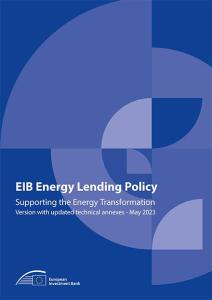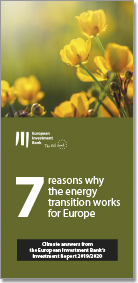Key features
Our Energy Lending Policy sets ambitious standards for clean energy financing while ensuring a just transition. We've established clear criteria for project selection and enhanced support mechanism for regions facing specific challenges.
Strict emissions standard
We only support power generation projects that emit less than 250g CO2/kWh, making us a leader in clean energy financing.
End of fossil fuel financing
In 2019, we decided to end financing for unabated fossil fuel energy projects, including gas*.
Supporting Just Transition
The EIB partners with the European Commission to support investment through a Just Transition Fund.
Four themes
We have pledged to support €1 trillion in climate action and environmental sustainability investments by 2030. In the energy sector we are focusing on four key areas that can drive the transformation while ensuring energy remains secure, sustainable and affordable.
Reducing the amount of energy needed to heat our homes or power our factories is one of the most effective ways to meet Europe’s energy and climate goals. Investing in energy efficiency brings many benefits:
- improves the competitiveness of EU industries by cutting energy costs;
- reduces the amount of carbon industries emit when producing goods and services;
- pushes the EU economy to be more sustainable environmentally and less dependent on foreign sources of energy.
How we help
Three-quarters of buildings use more energy than they need to. These buildings account for more than one-third of the European Union’s total carbon emissions. The European Commission wants to at least double the amount of energy-related building renovation by 2030.
Energy efficiency can be improved in all corners of the economy. To encourage energy savings, the EIB tries to embed efficiency in all its projects, such as schools or housing projects.
We also recognise that small companies and industries represent the biggest opportunity for energy efficiency improvements, but these businesses can have difficulties obtaining the finance needed to pay for those works. We address these issues by supporting small businesses through targeting lending that is often provided in partnership with domestic banks.
Find out more about our technical support for energy efficiency investments
Renewable energy like solar or wind power will play a pivotal role in achieving the European Union’s climate targets, by allowing us to replace fossil fuels used in heating or transportation with electricity generated from renewable sources. To do that, however, we must drastically increase renewable sources in our energy supply:
- The European Union wants renewable energy to account for 32% of all energy production by 2030.
- To meet the 2030 goals, the European Union must more than double renewable generation and capacity.
- Adequately storing and transporting that energy within Europe will require upgrades to our existing electricity networks and new ways to store renewable energies, whose generation can fluctuate.
How we help
Rapidly expanding renewable energy will require new investments in wind and solar, but also in alternative energies such as low-carbon gases (for example hydrogen, biogas) and renewable heat, such as biomass and geothermal energy.
Onshore and offshore wind power and solar photovoltaics represent the core of the EIB’s support for cleaner electricity production. The EIB has played an important role in supporting offshore wind projects and aided growing industry suppliers.
In December 2023, the EIB Board of Directors agreed to provide €5 billion to support commercial bank guarantees for companies providing components to the wind power industry. The funds are expected to mobilise up to €80 billion of investment in wind power and increase new installed generation capacity by 32 GW. Improving access to finance is a cornerstone of the European Wind Power Action Plan, announced by the European Commission in October 2023.
In addition to supporting renewable energy production, the EIB will help finance projects that integrate renewable sources into existing energy markets and regional exchanges, allowing clean sources to flow through Europe.
The climate and energy challenges Europe faces require boosting innovation and developing sustainable technologies and business models. Innovate sustainable technologies face several hurdles, however:
- many of these technologies are still in early development;
- those in development often need to improve their performance and lower their cost to be economically viable;
- many of the companies developing these technologies are small firms or start-ups, making them a risky investment for banks or other financiers.
How we help
The EIB supports companies through in all stages of development in line with the EU Strategic Energy Technology Plan and the new Innovation Fund.
To finance small, innovative firms, the EIB uses tailored financial instruments such as venture debt and equity funds. We also provide advisory services to help businesses develop and deploy products and solutions and find markets for them.
Transitioning to new, sustainable sources of energy requires new infrastructure that can integrate renewable energy and use it to produce electricity, which will increasingly power the EU economy. Some key challenges include:
- enabling renewable energy to flow between EU countries and regions by increasing energy connections;
- managing and operating power networks efficiently and intelligently;
- developing electric solutions for transport and building the infrastructure to support those new vehicles, such as charging stations for electric cars.
How we help
EIB support is helping to attract investment into power grids, enabling them to integrate renewable energies such as wind and solar and allowing that power to be transported across countries and regions.
We are also investing in energy storage and alternative solutions such as mini-grids, which provide electricity to communities not connected to a major power grid. These solutions increase the reliability of the electricity supply, while also increasing access, particularly in countries beyond the European Union.
Electricity will only get us part of the way to decarbonisation. The EIB also finances the development of infrastructure to transport low-carbon gases, including the rehabilitation and adaptation of existing gas infrastructure and the expansion and modernisation of district heating and cooling networks. These efforts contribute to efficient and climate-friendly energy production and consumption.
What is eligible
The detailed rules and criteria defining which types of energy investment can be supported by the EIB are further elaborated in the Annexes I to IV of the Energy Lending Policy:
- Energy efficiency
- Low-carbon energy supply
- Innovation and new types of energy infrastructure
- Enabling infrastructure
You can find additional information on our:
Public consultation
The ELP was adopted in November 2019 by the EIB Board of Directors. The EIB Group conducted a public consultation on its Energy lending policy from January to March 2019.
The review of the Energy lending policy was an open and inclusive process, involving industry, institutions, civil society and the public at large.
Key publications
Energy: Overview 2024
This publication gives an overview of the European Investment Bank’s support to energy.
EIB energy lending policy
This document informs EIB’s stakeholders on how the Bank supports EU energy policy (including updated technical annexes).
7 reasons why the energy transition works for Europe
The European Union’s transition to net-zero carbon emissions by 2050 is a big challenge, but also a massive opportunity to modernise the continent’s economy and promote growth, employment, technological advancement and social inclusion.


